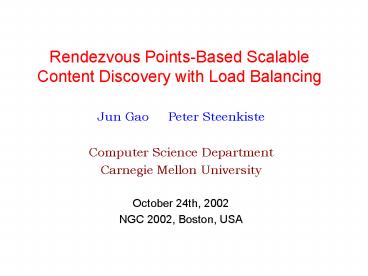Rendezvous Points-Based Scalable Content Discovery with Load Balancing - PowerPoint PPT Presentation
Title:
Rendezvous Points-Based Scalable Content Discovery with Load Balancing
Description:
Content Discovery System (CDS) Example: a highway monitoring service ... CDS layer determines where to register contents and send queries ... – PowerPoint PPT presentation
Number of Views:34
Avg rating:3.0/5.0
Title: Rendezvous Points-Based Scalable Content Discovery with Load Balancing
1
Rendezvous Points-Based Scalable Content
Discovery with Load Balancing
- Jun Gao Peter Steenkiste
- Computer Science Department
- Carnegie Mellon University
- October 24th, 2002
- NGC 2002, Boston, USA
2
Outline
- Content Discovery System (CDS)
- Existing solutions
- CDS system design
- Simulation evaluation
- Conclusions
3
Content Discovery System (CDS)
- Example a highway monitoring service
- Cameras and sensors monitor road and traffic
status - Users issue flexible queries
- CDS enables content discovery
- Locate contents that match queries
- Example services
- Service discovery P2P pub/sub
sensor networks
Snapshot from traffic.com
4
Comparison of Existing Solutions
Distributed
Solutions
Graph-based
Centralized
Tree-based
Design Goals
Query broadcasting
Registration flooding
Hash-based
Hierarchical names
yes
yes
yes
Look-up
Searchability
Robustness
yes
yes
no
yes
no
yes
Scalability
yes?
no
no
yes
yes?
no
no
Load balancing
no
yes?
5
CDS Design
- Attribute-value pair based naming scheme
- Enable searchability
- Peer-to-peer system architecture
- Robust distributed system
- Rendezvous Points-based content discovery
- Improve scalability
- Load Balancing Matrix
- Dynamic balance load
6
Naming Scheme
CN1
- Based on Attribute-Value pairs
- CN a1v1, a2v2,..., anvn
- Not necessarily hierarchical
- Attribute can be dynamic
- Searchable via subset matching
- Q ? CN
- Number of matches for a CN is large
- 2n-1
Camera ID 5562 Highway I-279 Exit 4 City
Pittsburgh Speed 25mph Road condition Icy
Q1
Highway I-279 Exit 4 City Pittsburgh
Q2
City Pittsburgh Speed 25mph
7
Distributed Infrastructure
Application
CDS
- Hash-based overlay substrate
- Routing, forwarding, management
- Node ID ? Hash function H(node)
- Application layer publishes contents or issues
queries - CDS layer determines where to register contents
and send queries - Centralized and network-wide flooding are not
scalable - Idea use a small set of nodes as
Rendezvous Points
Hash-based Overlay
TCP/IP
N3
N2
N1
N5
N4
N7
N6
N8
N9
8
RP-based Scheme
CN1 a1v1, a2v2, a3v3, a4v4
- Hash each AV-pair to get a set of RPs
- RP n
- RP node stores names that share the same pair
- Maintain with soft state
- Query is sent directly to an RP node
- Use the least loaded RP
- RP node fully resolves locally
CN2 a1v1, a2v2, a5v5, a6v6
CN1
CN2
N5
N3
N2
N6
N1
N4
N9
N7
N8
9
System Properties
- Efficient registration and query
- O(n) registration messages n small
- O(m) messages for query with probing
- Hashing AV-pair individually ensures subset
matching - Query may contain only 1 AV-pair
- No inter-RP node communication for query
resolution - Tradeoff between CPU and Bandwidth
- Load is spread across nodes
- Different names use different RP set
10
Load Concentration Problem
- RP node may be overloaded
- Some AV-pairs more popular than others
- Speed55mph vs. Speed95mph
- P2P keyword follows Zipf distribution
- However, many nodes are underutilized
- Intuition use a set of nodes to share load
caused by popular pairs - Challenge accomplish load balancing in a
distributed and self-adaptive fashion
Example Zipf distribution
of names
100000
10000
1000
100
10
1 10 100 1000 10000
AV-pair rank
11
Load Balancing Matrix (LBM)
LBM for AV-pair a1v1
- Organize nodes into a logical matrix
- Each column holds a partition
- Rows are replicas of each other
- Node IDs are determined by H(a1v1, p, r) ?
N1(p,r) - Matrix expands itself to accommodate extra load
- Increase P when registration load reaches
threshold - Query load ? ? R ?
12
Registration and Query with LBM
Registration
CN1a1v1, a2v2, a3v3
- Determine LBM size
- Register with one random column of each matrix
- Compute IDs locally
0,0
1,1
2,1
3,1
1,2
2,2
3,2
LBM3
1,3
2,3
3,3
LBM2
LBM1
Load is balanced within an LBM
13
System Properties with LBM
- Registration and query cost for one pair
increases - O(R) registration messages
- O(P) query messages
- Matrix size depends on current load
- LBM must be kept small for efficiency
- Query optimization helps, e.g., large P ? small R
- Matrix shrinking mechanism
- E.g., May query a subset of the partitions
- Load on each RP node is upper-bounded
- Efficient processing
- Underutilized nodes are recruited as LBM expands
14
Simulation Evaluation
- Implement in an event-driven simulator
- Each node monitors its registration and query
load - Assume Chord-like underlying routing mechanism
- Experiment setup
- 10,000 nodes in the CDS network
- 10,000 distinct AV-pairs (50 attributes, 200
values/attribute) - Use synthetic registration and query workload
- Performance metric success rate
- System should maintain high success rate as load
increases
15
Workload
Registration load
Query load
Number of names
Number of queries
Rank of AV-pairs
Rank of AV-pairs
16
Registration Success Rate Comparison
Threshold 50 reg/sec Poisson arrival Pmax 10
Registration success rate ()
Avg. registration arrival rate (1000 reg/sec)
17
Query Success Rate Comparison
Threshold 200 q/sec Poisson arrival Rmax 10
Query success rate ()
Avg. query arrival rate (1000q/sec)
18
Conclusions
- Proposed a distributed and scalable design to the
content discovery problem - RP-based approach addresses scalability
- Avoid flooding
- LBMs improve system throughput
- Balance load
- Distributed algorithms
- Decisions are made locally































